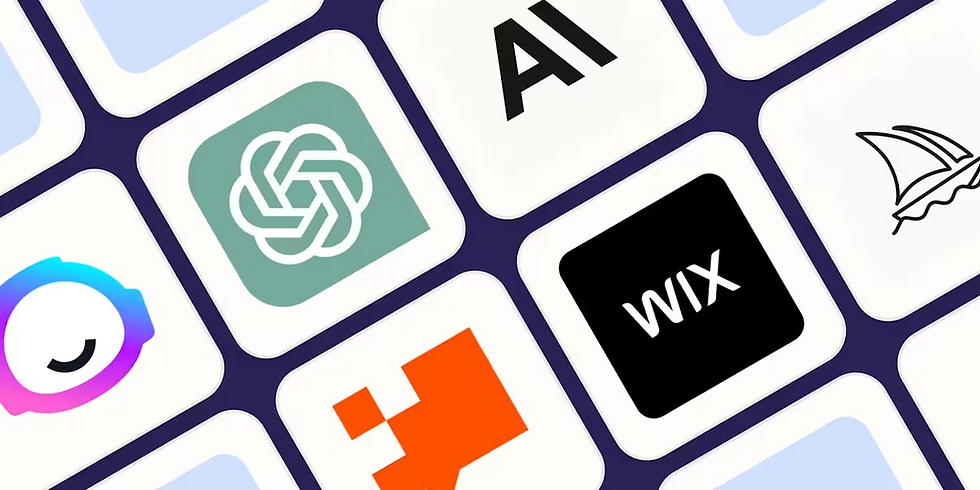Top AI Tools Every Designer Should Know in 2025
- eventslabsydney

- Jul 27
- 4 min read
Supercharge Your Creativity, Workflow, and Client Impact with Intelligent Design Tools
As designers, we’ve always stood at the intersection of creativity and technology. But in 2025, that intersection has become a fast-moving expressway—fueled by the incredible momentum of artificial intelligence. What was once considered experimental or futuristic is now integrated into our daily workflows, changing how we ideate, create, and deliver design.
Whether you’re a graphic designer, motion artist, UI/UX professional, or content creator, embracing AI doesn’t mean compromising your vision—it means amplifying it. Below are the most powerful AI tools shaping design today, each offering unique capabilities that support both the artistic and strategic sides of design work.

1. Adobe Firefly
Adobe’s powerful AI engine brings generative design capabilities straight into the tools you already know—Photoshop, Illustrator, and Express. From generating background elements to expanding scenes or crafting entirely new visuals based on prompts, Firefly eliminates tedious steps and opens creative possibilities.
Best for rapid prototyping, visual experimentation, client revisions, social content.
Pro Tip Firefly is trained on licensed and safe content, so you can confidently use generated images in commercial work.
2. Runway ML
Runway is revolutionizing video and motion graphics. It allows you to erase backgrounds, color grade, and edit videos with just a few clicks—and now even offers text-to-video generation. It’s like having a post-production team in your browser.
Best for creative video content, short reels, visual storytelling, TikToks, and campaigns.
Standout Feature Gen-2 by Runway can turn static images or prompts into animated video clips.
3. Figma + AI Plug-ins
Figma remains a UI/UX favorite, and its growing library of AI plug-ins now lets you generate interface layouts, write UX copy, and even develop user flows just by describing them. This enhances team collaboration and slashes hours from early-stage development.
Best for wireframes, A/B testing, idea pitching, design systems.
Smart Use: combine with FigJam for ideation, then instantly create wireframes or flows from brainstorming sessions.
4. Khroma
Struggling to find the right color palette? Khroma is an AI-powered color tool that learns your taste and suggests unique, on-brand palettes. Unlike static swatch sites, it evolves as you do.
Best for branding, moodboards, website design, pitch decks.
Bonus you can explore color usage in typography, gradients, and background pairings, tailored to your style.

5. Looka / Brandmark
Need to quickly build a logo and brand identity? Looka and Brandmark are AI-based platforms that help generate logos, type pairings, brand color palettes, and even full brand kits in minutes.
Best for side projects, MVPs, branding decks, time-sensitive pitches.
Quick Win great for freelancers or agencies working with startups needing fast turnarounds.

6. Canva Magic Studio
Canva’s AI suite, Magic Studio, continues to be a top pick for marketers and non-designers—but it’s also evolving into a powerful tool for professionals. Magic Write, Magic Design, and Magic Expand let you do copy, layout, and visual edits almost instantly.
Best for social media content, client presentations, branded templates.
Why It’s Powerful: it democratises design while still offering control to professionals who want to customize further.
7. Midjourney & DALL·E 3
These are the pioneers of generative imagery. Midjourney’s aesthetic leans toward detailed, artistic, and surreal, while DALL·E 3 offers more literal, prompt-accurate image creation (especially when integrated with tools like ChatGPT or Bing).
Best for : Concept art, campaign ideas, surreal compositions, visual storytelling.
Creative Edge: Generate style frames, moodboards, or alternative compositions to spark creative discussion with clients.
8. KREA.ai
A newer but powerful platform, KREA offers real-time, style-forward image generation tailored for creatives. It’s intuitive, fast, and capable of evolving into your go-to ideation tool for editorial visuals or product concepts.
Best for exploratory design, fashion lookbooks, packaging concepts, AI sketching.
Why It’s Special: its interface feels less “techy” and more “designer-friendly,” reducing the AI learning curve.
9. Framer AI
If you’ve ever wished, you could build a website straight from your creative thoughts—Framer AI does exactly that. With a prompt and a few tweaks, you’ll have a responsive website, complete with interactions and modern design.
Best for client demos, portfolio sites, landing pages.
Efficiency Tip: use Framer to generate a mockup, then export or rebuild in Webflow or custom code later if needed.
10. Uizard
Uizard turns sketches and simple inputs into clickable prototypes for websites or mobile apps. It’s perfect for ideation stages when speed is critical, but quality can’t be sacrificed.
Use it for UX sprints, MVPs, pitch decks, agile prototyping.
Bonus: It also helps non-designers participate in product development without compromising design quality.
Final Thoughts
AI won’t replace designers—but designers who use AI will likely outpace those who don’t. These tools are reshaping the creative landscape, allowing you to work smarter, faster, and with more imagination than ever before.
Embrace AI not as a shortcut, but as a creative co-pilot that lets you focus more on ideation, storytelling, and user experience—while the machines take care of the grunt work.
Start small. Choose one or two tools that align with your current workflow. Play, experiment, and see where AI can save time, inspire new directions, or elevate your outcomes. The future isn’t just coming—it’s already in your toolbelt.




Comments